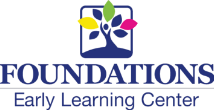Our Approach to Learning
At Foundations, we focus on your child’s development – from social-emotional and physical development to problem solving, literacy, math, science and social studies.
And there’s a reason behind everything we do. Here’s how we approach our learning environment to ensure the very best for your child.
Play-Based Learning
For years, researchers have studied which classroom experiences lead to a solid learning foundation for young children.
When many of us think about school, we remember when we were in first or second grade and think about desks, worksheets, drills, and homework. We think that for our child to be prepared for these learning tasks, we should introduce them earlier and earlier.
In fact, research shows us the opposite is true. Young children with an opportunity to engage in play-based learning in intentionally-designed classrooms with caring educators are best prepared for long-term success in school and beyond.
At Foundations, we incorporate this research into play-based active learning in each classroom and in each learning experience we create for your child.
How to Recognize Active Learning in a Classroom
You may be unfamiliar with the term “active learning,” but it’s easy to identify in action! When trying to determine if a learning environment is built around active learning, just remember the acronym HOMES.
Children learn better when they can manipulate real objects. These real objects allow them to create a sort of filing folder system in their brains where they can store more and more information as they gain it.
Open-ended experiences or questions are those that don’t have just one answer or one right way. They force children to think through possibilities, create and test hypotheses, and explore how things change and interact when used in different ways.
A learning experience is more powerful when we connect it to something already interesting to a child. We can teach literacy by reading stories about horses or writing the names of horses. We can teach math by counting how many seeds get planted in a garden. Whatever is meaningful to a child can be turned into a learning experience.
The best learning experiences give children opportunities to move. Often, when a child sits passively for a long period of time, the brain disengages and learning stops. In our classrooms, moving children are learning children.
Young children are sensory-motor learners. Not only do they need to move their bodies, they need sensory engagement. Recent studies warn that too much sensory input can lead to overload, and lessened learning. That is why our classrooms balance a neutral pallet with interesting things to see, hear, feel, touch, and taste.
One long-term study shows the benefits of active learning when your child is young continue to exist and even grow as children (now adults) enter their 40’s!
So, the next time you see your child at play, think of HOMES, and look for the aspects of active learning at work.
Child’s play is more than just play! It is your child developing the tools he or she will need to be a problem solver and make a mark in our world.
Classroom Spaces Designed for Learning
The learning experiences we provide for your child sets the stage for the rest of their lives. Your child deserves a space where their body and mind can not only develop, but thrive!
Our learning environments are intentionally designed to give your child’s brain and body everything they need at each stage of development:
Infants
Babies need to move! We limit the time your infant is in a device (i.e. swings, bouncy seats, etc.) and ensure there’s plenty of space for them to move and explore interesting materials to exercise their brains.
Toddlers/Two’s
This stage is all about independence and developing and using new thinking and physical skills. Children assert their independence as they make choices from low shelves and navigate the room and routine “all by myself.”
Preschool/Pre-K
These classrooms open doors to big things. Our specialized technology moves your child beyond the classroom walls and into learning that can take them anywhere.
School-Age Children
At this age, it’s about hanging out with friends and having fun. Our classrooms have spaces for everything to make your child comfortable, engaged in fun learning, and enjoying life when school is not in session.
Interested in finding out more about our learning environments?
Ask your Center Director or your child’s teacher for more information
